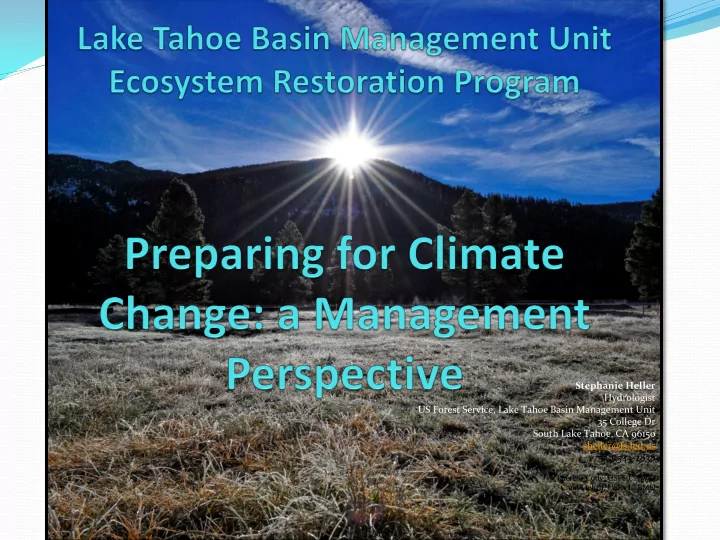

Stephanie Heller Hydrologist US Forest Service, Lake Tahoe Basin Management Unit 35 College Dr South Lake Tahoe, CA 96150 sheller@fs.fed.us 530-543-2838 Theresa Cody, USFS LTBMU Craig Oehrli, USFS LTBMU
• Forest Service Policy • Expected climate change impacts • How to prepare for climate change • Project Examples
FSM 2000 – National Forest Resource Management Chapter 2020 – Ecological Restoration and Resilience 2020.3.2 – “Establish ecological restoration goals and objectives in strategic plans to maintain the adaptive capacity of ecosystems – recognizing uncertainty related to climate change.”
National Roadmap for responding to Climate Change (FS- 957b, February 2011)
• Goal: “Retain and restore ecological resilience of the National Forest lands to achieve sustainable ecosystems….especially under changing and uncertain future environmental conditions such as those driven by climate change” R5-MR-048, March 2011
• Accomplishments within next 15-20 years • Restore at least 50% accessible, degraded forest meadows to improve their habitat function and ability to hold water longer into the summer and deliver clean water when most needed….within 15 -20 years • Ecosystem Services and Community Economic Benefits Enhanced Delivery of clean water and improved flow regime that benefits people, fish and wildlife Fish, wildlife and plant habitat for common and rare species Maintenance of biodiversity Forest resilience in the face of climate change and changing disturbance processes
Mission Statement: • Restore ecosystems to healthy, diverse, and productive conditions that meet the needs of present and future generations. • Program objectives: • Restore natural processes that sustain healthy ecosystem function. • Coordinate with other LTBMU programs to facilitate an interdisciplinary approach to ecosystem restoration that meets the goals of the Land and Resource Management Plan. • Promote holistic ecosystem management through collaboration with public and private organizations, adjacent landowners, and the public. • Develop internal and external outreach, environmental education, and information technology transfer.
• Increased percent rain, decreased percent snow, earlier snowmelt • Earlier and increased peak flows • Earlier onset of base flows and reduced base flows • Greater potential for flood flows • Warmer stream temperatures Impaired conditions for aquatic wildlife • Increased vulnerability to invasive species • Greater algal growth • • Drier site conditions Increased likelihood of wildfire • Drier vegetation outcompetes wetter species • Increased frequency of drought •
1. Increase Resistance to change 2. Promote Resilience to change 3. Enable Ecosystems to Respond to change 4. Realign condition to current and future dynamics 5. Reduce greenhouse gases and Reduce non-renewable energy use (http://www.fs.fed.us/ccrc/)
“Homeland Security” approach Most appropriate for: • Endangered/Threated species • Extreme fire risk • Invasive species
Healthy ecosystems are more resilient to change Important to take preventative steps to “heal” impaired ecosystem Improve the capacity to return to desired prior conditions after climate-induced disturbance.
Anticipate and plan for risk What are the risks of climate change? Increased percent rain, decreased percent snow, earlier snowmelt Drier site conditions Warmer stream temperatures Experiment creatively and learn from experiments “Bet - hedging practices” Increase diversity Heterogeneous ecosystems better able to withstand change Promote connected landscapes • Allows species to move in response to change
• Design projects for current conditions, not pre-European settlement. • Use historic record to inform future coditions.
Cookhouse Meadow on Big Meadow Creek Restoration Completed October 2006
Cookhouse Meadow on Big Meadow Creek 1968 Historic channel condition Current channel condition 1978 1981
Cookhouse Meadow on Big Meadow Creek Restoration Plan Overview Constructed channel Filled channel
Cookhouse Meadow on Big Meadow Creek Implementation 2005-2006 Block off old channel & put flow in new channel Partial backfill of old channel Construct new channel -2005 Fill old channel -2006
Cookhouse Meadow on Big Meadow Creek July 2011
High Meadows Complex Restoration Implementation 2010-2012 and beyond Photo August 2008
Cold Creek/ High Meadow Diversion System • Meadow Grazed from late 1800’s to 2002 • Diversion system in place since at least 1940 • Has not been maintained since 2002
Cold Creek/ High Meadow Bank Stability Rating, 2006
High Meadow Complex Restoration
New Cold Creek main stem channel with substrate
Upper Truckee Reach 5 Restoration Implementation 2013-2016
Upper Truckee Reach 5 Restoration Proposed Alignment Overview Insert Upper Truckee Plan Overview
Resistance 1. Resilience 2. Response 3. 4. Realign Reduce 5. For more information visit the Forest Service Climate Change Resource Center http://www.fs.fed.us/ccrc/
Recommend
More recommend